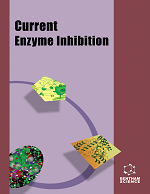- Home
- A-Z Publications
- Current Enzyme Inhibition
- Previous Issues
- Volume 4, Issue 1, 2008
Current Enzyme Inhibition - Volume 4, Issue 1, 2008
Volume 4, Issue 1, 2008
-
-
Toward Inhibitors of Protein Tyrosine Phosphatases for Cancer Treatment
More LessAuthors: Alban Sidhu, Marie-Odile Contour-Galcera, Dennis Bigg and Gregoire PrevostProtein tyrosine phosphatases (PTPs) and their inhibitors have been more and more studied during the past decades. Dephosphorylation is implicated in many biological events including the progression of the cell cycle. Around two hundred PTPs are known in humans, divided into three main groups. They all have a common amino acid sequence in their active site, referred to as the C(X)5R motif, namely a cysteine follo Read More
-
-
-
Effect of Nitric Oxide Synthase Inhibition on Body Temperature Control During Endotoxemic Shock
More LessAuthors: Evelin C. Carnio and Rafael S. SaiaSeptic shock is a major cause of death following trauma and a persistent problem in surgical patients. It is a challenge to the critical care medicine specialist and carries an unacceptable high mortality rate, despite adequate antibiotic and vasopressor therapies. The prevalent hypothesis regarding its mechanism is that the syndrome is caused by an excessively defensive and inflammatory response. During the acute phas Read More
-
-
-
Targeting 5-Lipoxygenase for Prevention and Treatment of Cancer
More LessAberrant arachidonic acid metabolism has been recognized as a dominant mechanism underlying the development and progression of a range of human cancers. Metabolism of arachidonic acid through the 5-lipoxygenase (5-Lox) pathway generates an array of highly reactive eicosanoids categorized into two distinct groups; the leukotrienes (LTs) and the 5-hydroxyeicosatetraenoids (5-HETEs). Evidence documenting promin Read More
-
-
-
Calcineurin Inhibition and Development: Insights from Research Models
More LessBecause of its role in the T cell response, pharmacological inhibition of calcineurin is clinically useful to suppress the immune system following organ transplantation. Introduction of calcineurin inhibitors (CIs) in the early 1980s resulted in a profound improvement in graft survival. For this reason, calcineurin inhibitors have become a cornerstone for post-transplant management. CIs are also used to treat an increasingly wi Read More
-
-
-
Nitric Oxide Synthase Function in Exercise
More LessAuthors: Pasquale Pagliaro, Daniele Mancardi and Claudia PennaEndothelial cells (ECs) regulate blood flow and pressure, platelet aggregation, and angiogenesis. Chemical (e.g. acetylcholine, bradykinin) and mechanical stimuli (linear shear stress and pulse pressure) enhance endothelial production of nitric oxide (NO). In the mammalian three isoforms of NO synthase [endothelial (eNOS), inducible (iNOS) and neuronal (nNOS)] are expressed in different cell types showing a specific subcellul Read More
-
-
-
Fungal Enzyme Inhibitors as Pharmaceuticals, Toxins and Scourge of PCR
More LessTo indicate the importance of fungal enzyme inhibitors (FEI) it is only required to mention penicillin. However, many other natural products from fungi have been described. Combinatorial chemistry (CC) is not providing the medicines that were predicted and it is time to return to natural products (NP). The inhibitions of enzymes by FEI run the gamut of medicinal applications and toxicity. The field is, or should be, “big scie Read More
-
Volumes & issues
-
Volume 20 (2024)
-
Volume 19 (2023)
-
Volume 18 (2022)
-
Volume 17 (2021)
-
Volume 16 (2020)
-
Volume 15 (2019)
-
Volume 14 (2018)
-
Volume 13 (2017)
-
Volume 12 (2016)
-
Volume 11 (2015)
-
Volume 10 (2014)
-
Volume 9 (2013)
-
Volume 8 (2012)
-
Volume 7 (2011)
-
Volume 6 (2010)
-
Volume 5 (2009)
-
Volume 4 (2008)
-
Volume 3 (2007)
-
Volume 2 (2006)
-
Volume 1 (2005)
Most Read This Month
Article
content/journals/cei
Journal
10
5
false
en


